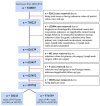Breast Cancer Incidence and Behavior in Younger Patients: A Study From the Surveillance, Epidemiology and End Results Database
- PMID: 32494315
- PMCID: PMC7239572
- DOI: 10.14740/wjon1278
Breast Cancer Incidence and Behavior in Younger Patients: A Study From the Surveillance, Epidemiology and End Results Database
Abstract
Background: Breast cancer screening for women less than 40 years old is practically non-existent. Since screening can detect cancer at an early stage, not having a surveillance guideline for breast cancer in younger women can result in detection of the cancer at advanced stages. The purpose of this study was to investigate the incidence and behavior of breast cancer in younger women.
Methods: The Surveillance, Epidemiology and End Results (SEER) registry data from 2004 to 2014 were accessed for the study. All women diagnosed with breast cancer and with complete information were included in the study. The data were further divided into two groups based on the age of the patient at the time of diagnosis. The younger group consisted of women < 40 years old (group 1) and the older group consisted of women ≥ 40 years old (group 2). Both groups were compared on demography and characteristics of the cancer. The continuous variables were tested using Student's t-tests and categorical variables were compared using Chi-squared or Fisher's exact tests. Multivariate analysis was done to find the association of high-grade cancer using a logistic regression model. All P-values are two-sided and values < 0.05 were considered statistically significant.
Results: Of 599,782 patients who satisfied the inclusion criteria, 28,243 (4.71%) diagnosed with breast cancer were younger women aged < 40 years old. A higher proportion of these younger women presented with larger tumor sizes (between 5.1 and 10.0 cm) (11.61% vs. 5.70%, P < 0.001), poorly differentiated cancer cells (55.88% vs. 32.85%, P < 0.001) and triple negative receptors (6.83% vs. 3.81%, P < 0.001) than older women respectively. Younger age was significantly associated with high-grade tumor at presentation when controlling for race and marital status. There was roughly 3% increased risk of a high-grade tumor with each decrease of 1 year (odds ratio 0.97, 95% confidence interval 0.96 - 0.99, P = 0.001).
Conclusion: This study found that the proportion of breast cancer cases in younger women was just below 5%; however, when the cancer was diagnosed, these women presented in advanced stages and more aggressive cancer types.
Keywords: Breast cancer; Prognosis; Young age.
Copyright 2020, Nasim et al.
Conflict of interest statement
The authors declare that there is no conflict of interest regarding the publication of this paper.
References
-
- Centers for Disease Control and Prevention (CDC). 2018. Breast Cancer Statistics. Retrieved from https://www.cdc.gov/cancer/breast/statistics/index.htm.
-
- Centers for Disease Control and Prevention (CDC). What Are the Risk Factors for Breast Cancer? 2018. Retrieved from https://www.cdc.gov/cancer/breast/basic_info/risk_factors.htm.
LinkOut - more resources
Full Text Sources

